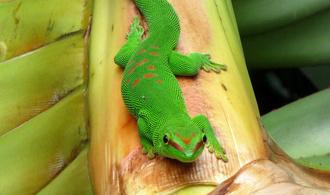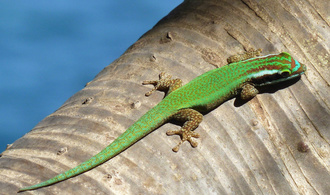The threat of the Madagascar giant day gecko
Written by Modified on the
Dr Steeves Buckland[1], researcher at the Mauritius National Parks and Conservation Service (NPCS) and the University of Bristol, recently warned against an invasive species now well known on the island and threatening its biodiversity: the Madagascar giant day gecko (Phelsuma grandis).
Like the Manapany green gecko or the Bourbon green gecko in Reunion Island, geckos endemic to Mauritius are facing a major new invader: the Madagascar giant day gecko. Introduced to the islands via trading in the early 90s, the gecko has since become widespread and continues to expand today, representing a major threat to the native biodiversity and fauna of the two islands.
Eating the same food resources and occupying the same habitat as native geckos, the Madagascar giant day gecko is also a direct predator. Steeves Buckland "fears the worst in the next ten or twenty years" if no suitable control method is found. According to him, studies show a "drastic impact on local biodiversity, causing up to 90%" decline of some species in several areas of Mauritius.
Excerpt from S. Buckland interview for Nature Indian Ocean ( NOI):
Control and management action plans were initiated in Reunion Island in 2013 to cope with the Madagascar giant day gecko, combining both population control (maintenance of density or an suitable distribution area) and eradication using several capture methods (manual, trapping, etc.).
- Follow this link for the Phelsuma grandis Regional Plan for the island of Reunion : www.especesinvasives.re.
- The Indian Ocean Nature awareness video on the BioAgri YouTube channel : youtube BioAgri.
- The stuggle continues against invasive species in Reunion : [ Terres d'ici - Antenne Réunion].
[1]Dr. Steeves Buckland has been involved since September 2014 in the project "Modelling and predicting the distribution of invasive species in the Mascarenes" within the PVBMT joint Research Unit and the Plant Protection Platform (Cirad - University of Reunion Island).



